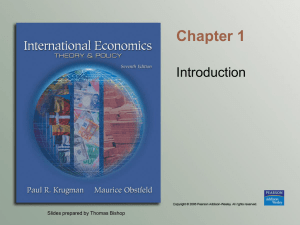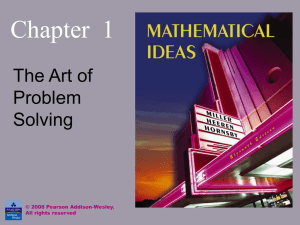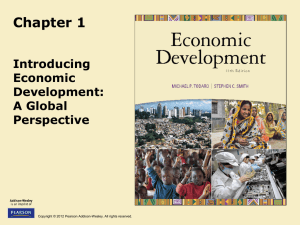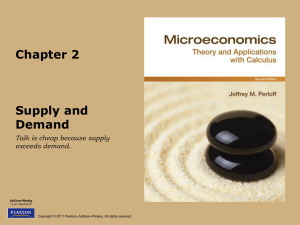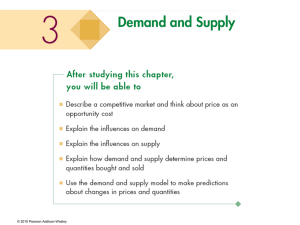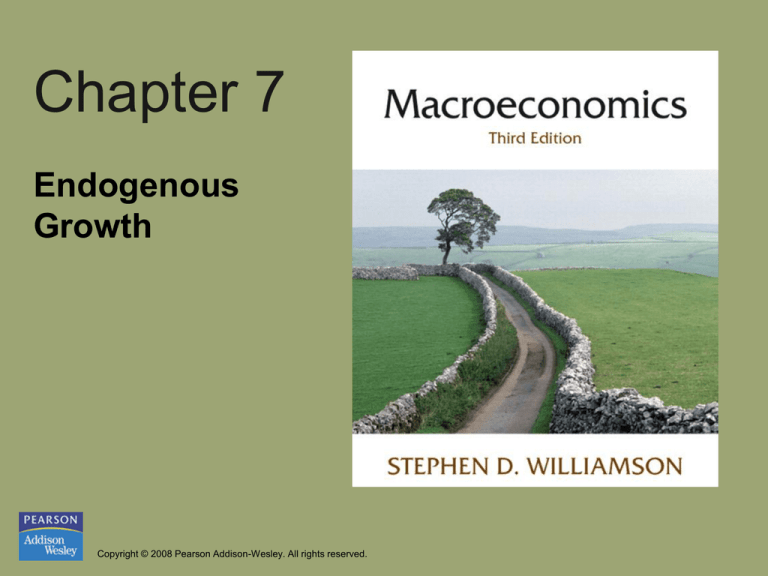
Chapter 7
Endogenous
Growth
Copyright © 2008 Pearson Addison-Wesley. All rights reserved.
Chapter 7 Topics
• Endogenous growth: a model of human capital
accumulation
• The Solow model predicts that sustained growth
in z can lead to sustained economic growth.
Endogenous growth model answers the question
of how to obtain sustained growth in z.
Copyright © 2008 Pearson Addison-Wesley. All rights reserved.
7-2
Endogenous Growth: A Model of
Human Capital Accumulation
• In this model, the growth rate of per capita income is
determined by the efficiency with which human capital
is accumulated, and the fraction of available time
devoted to human capital accumulation.
• Time allocation
– Work
– Human capital accumulation (education attainment)
• Tradeoff between current and future growth caused by
human capital accumulations.
Copyright © 2008 Pearson Addison-Wesley. All rights reserved.
7-3
Property of Human Capital Nonrivalry
• A particular person’s acquisition of knowledge does not
reduce the ability of someone else to acquire the same
knowledge.
• In contrast, physical capital investment is rivalrous:
acquiring equipment by one firm uses up resource and
limits the number of equipment available to other firms.
• Lack of diminishing returns to scale leads to unbounded
growth in the endogenous growth model.
Copyright © 2008 Pearson Addison-Wesley. All rights reserved.
7-4
Equation 7.1
Consumption is equal to total wage income.
uHs: efficiency unit of labor.
Hs: number of current period human capital stock.
u: time devoted in working in each period.
There is no saving, excluding investment in physical capital.
Copyright © 2008 Pearson Addison-Wesley. All rights reserved.
7-5
Equation 7.2 – Human Capital
Accumulations
Future human capital depends on current human
capital and time devoted to training and
education.
b: efficiency of HC accumulation process, exog. parameter.
1-u: time devoted in acquiring HC.
Copyright © 2008 Pearson Addison-Wesley. All rights reserved.
7-6
Equation 7.3: Production
Function
Copyright © 2008 Pearson Addison-Wesley. All rights reserved.
7-7
Equation 7.4: Firm’s Profits
1. If z < w, Hd =0.
2. If z > w, Hd goes to infinity.
3. If z = w, Hd can be any number. That is, firms are indifferent in Hd
Copyright © 2008 Pearson Addison-Wesley. All rights reserved.
7-8
Figure 7.5 Determination of the
Equilibrium Real Wage in the
Endogenous Growth Model
Copyright © 2008 Pearson Addison-Wesley. All rights reserved.
7-9
Equation 7.5
Equilibrium Consumption:
Copyright © 2008 Pearson Addison-Wesley. All rights reserved.
7-10
Equation 7.6
Human capital evolves in equilibrium according
to:
Copyright © 2008 Pearson Addison-Wesley. All rights reserved.
7-11
Equation 7.7
Equilibrium growth rate of human capital:
Growth rate of HC depends on b, u.
Copyright © 2008 Pearson Addison-Wesley. All rights reserved.
7-12
Figure 7.6 Human Capital
Accumulation in the Endogenous
Growth Model
Copyright © 2008 Pearson Addison-Wesley. All rights reserved.
7-13
Figure 7.7 Effect of a Decrease in u on
the Consumption Path in the Endogenous
Growth Model
If u decreases:
Consumption drops in current period.
Growth rate in C increases, leading to
higher consumption in future period.
Copyright © 2008 Pearson Addison-Wesley. All rights reserved.
7-14
Figure 7.8 No Convergence in the
Endogenous Growth Model
Copyright © 2008 Pearson Addison-Wesley. All rights reserved.
7-15
Model Fit - Convergence
• Consistent with data in the sense that there exists
persistent gap in income per capita between poor
and rich countries.
• Inconsistent with data in the sense that there
exists convergence in income per capital among
rich countries.
Copyright © 2008 Pearson Addison-Wesley. All rights reserved.
7-16
Human Capital Externalities
• HC externality exists when labor and capital are
mobile since mobility of L and K facilitates skill
transfer across countries, therefore, enhance
human capital accumulations in relative poor
countries.
Copyright © 2008 Pearson Addison-Wesley. All rights reserved.
7-17





